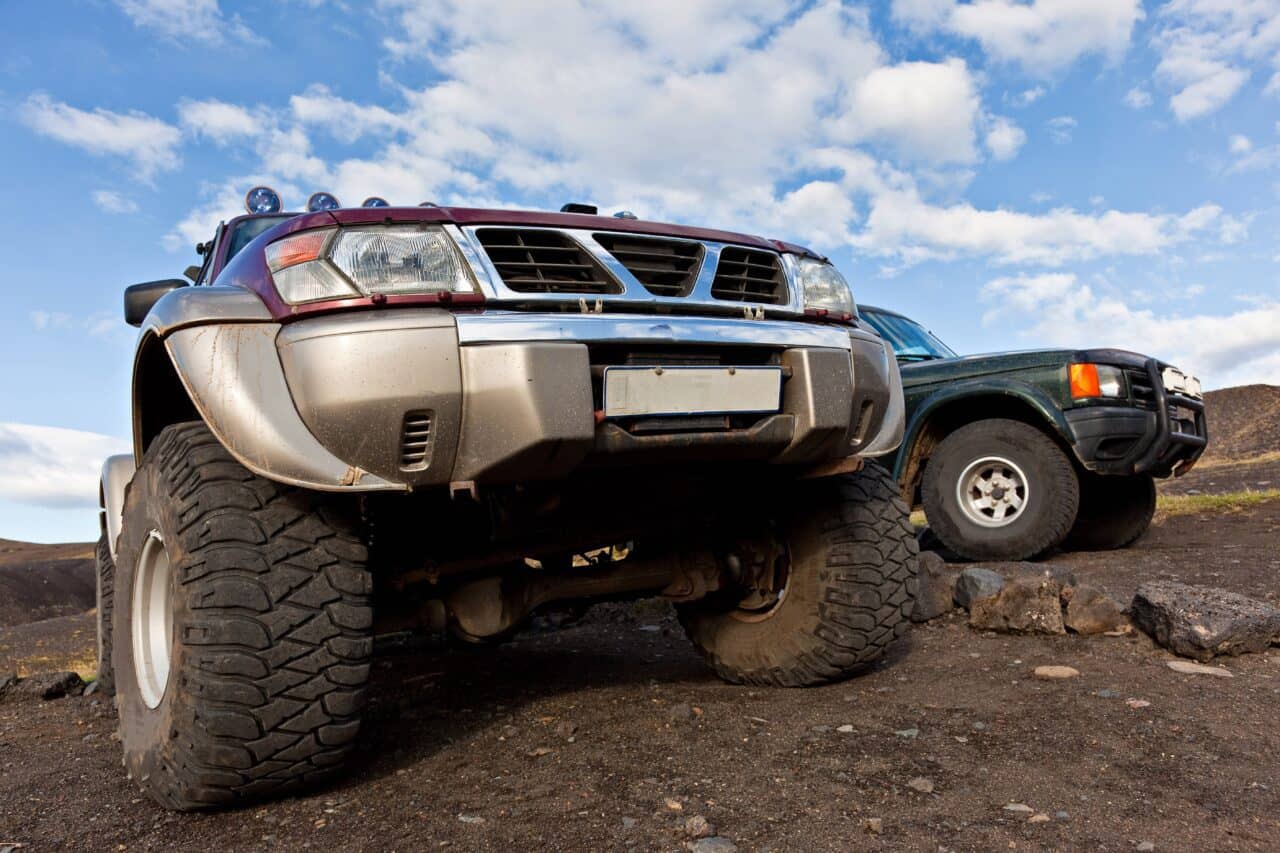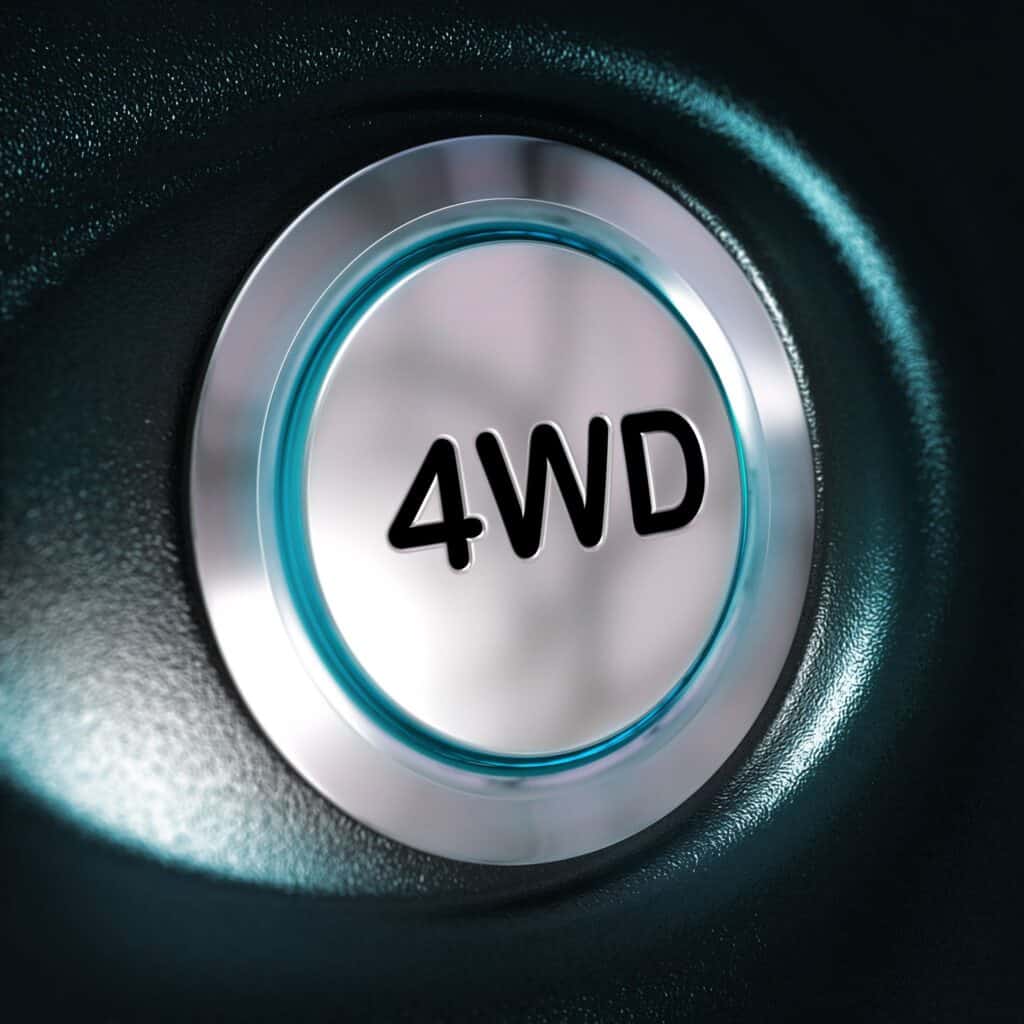Is Full-Time 4WD the Same as AWD?

Four wheel drive and all wheel drive on the surface seem to mean the same thing. Cars have four wheels, so a car with all wheel drive should be the same thing as a car with four wheel drive. This basic conclusion seems like a perfectly legitimate deduction, but it oversimplifies something that is really much more complex than that.
4WD and AWD are not the same. In both cases, power is delivered to all four wheels at the same time, and in both cases, that power is delivered constantly. However, AWD has no capacity for low gear, making them less versatile off-road than a full-time 4WD.
4WD systems are quite complex and differ in several key ways from AWD systems. Understanding that difference is crucial in making the best choice in the vehicle for you. It will also help you in figuring out how to get the most out of your car.
How Full-Time 4WD works
In order to have a good understanding of how a full-time 4WD works, it is important to have a grasp of how a part-time 4WD works.
In simple terms, part-time 4WD vehicles function by having an engine that turns a driveshaft. That driveshaft connects to the axels which are connected to the wheels. Where the connection to the axel occurs, a differential is present, which allows different amounts of force to supply each wheel.
A problem arises here. The force from the driveshaft will always take the easiest path, so if one wheel is on a patch of ice and spinning freely, 100% of the power from the driveshaft will go to that wheel. To solve this problem, most vehicles have a differential lock option, which creates an even distribution of force.
Part-time 4WD vehicles have three primary options to drive in–two wheel drive, high four wheel drive, and low four wheel drive.
Without 4WD engaged, only the rear axle receives power from the driveshaft. For general on-road travel, this provides ample force to move the vehicle.

When entering difficult terrain, like off-road or icy conditions, the driver of the vehicle can activate 4WD which makes the drive shaft supply power to the front axle as well as the rear. This evenly distributes the force between the front and rear axels.
This is great for off-road or low traction, but bad for everyday driving because it turning with this engaged causes tension buildup in the driveshaft, which can lead to damage if it isn’t released. This happens because, with locked differentials, the wheels can’t turn at different rates, which is absolutely essential for turning.
In short, part-time 4WD causes a lot of problems if it isn’t used correctly. It can be difficult, then, to imagine how you could have full-time 4WD. The answer is having a center differential. The center differential allows for variation in force provided to the front and back axels in addition to the individual wheels.
Through this, a full-time 4WD can function almost in 2WD when necessary, or full 4WD. Like part-time 4WD, full-time 4WD has a low four wheel, or 4L, option.
This option lowers the gears the car will drive in, which allows the driveshaft to turn at one rate while the wheels turn at a lower rate. This increases torque (a fancy word for rotational force), which means the force applied to the ground by the tires increases.
This increase in force improves the ability of a vehicle to climb a steep hill. Even though the vehicle will be moving more slowly, the capacity it has to climb or maneuver other difficult terrain is greatly increased.
This was a huge set of information, and it can be really difficult to understand this sort of thing without any sort of visual aid. Because of that, I’ve linked a video that gives a general overview of 4WD systems that should help make things clearer.
How AWD works
All-wheel-drive systems work very similarly to the way that four-wheel-drive systems work–both are propelled by powering all four of the vehicle’s wheels. Similar to the existence of part-time 4WD and full-time 4WD, there are vehicles with automatic AWD and standard AWD.
Automatic AWD for the most part runs like a 2WD vehicle. In everyday use, only the rear or front wheels will receive power. Once those tires begin to slip on more difficult terrain, the AWD system kicks in to provide more traction in the vehicle. This is done by an onboard computer.
A standard AWD vehicle has power running to each wheel all the time. Unlike a full-time 4WD system, AWD vehicles have a dedicated computer that optimally distributes the force between the four wheels for the best performance possible. The computer controlling power distribution removes the need for manual differential locks in everyday use, so they aren’t there.

Aside from the presence of a computer system governing the distribution of force amongst the wheels on the vehicle, the main difference between AWD and 4WD is the ability to use 4 Low in a 4WD car. AWD vehicles have no equivalent to 4 Low, which is their primary disadvantage.
How the Difference Impacts Performance
Obviously, there are differences in the way these two vehicle systems function, but the real question isn’t about the mechanical differences between the two, it is about the way that each system performs.
AWD vehicles are designed for driving on the road. They are great for that function, but they are limited in versatility because that is their intended function. The lack of differential locks and the absence of lower gear options limit the capacity of an all-wheel-drive vehicle.
The absence of those functions and the presence of the computer system governing operation make AWD vehicles easier to drive and compromise less on fuel economy and efficiency on the road.
Most off-road drivers agree that AWD is good for only light off-roading; heavy or intense off-road travel is too much. The compromises it makes for being optimal for road travel are inhibiting. If you drive an AWD vehicle, it’s probably best to stick to the roads and maybe hop off the beaten path now and again to find the perfect campsite, or reach your trailhead.
But if you are serious about taking the road less traveled by, the best option for you will be to pick a vehicle with 4WD. While 4WD may not have all of the advantages on pavement that AWD has, it is designed to be taken off the pavement and to go wherever you desire to go.
Differential locks and 4 Low solidify 4WD’s place as the king of off-roading. Not only will you be able to take your car off the beaten path, but you be also able to take your car off any path you want. Some vehicles can climb inclines of well over 45 degrees, which opens so many routes that are closed to any other vehicle. You will also have the ability to drive on many different surfaces–solid, irregular rock; loose grave; deep sand; and many many more.
For a more visual representation of the difference between these two systems, I’ve linked a video below. The video gives a general overview, as well as a brief demonstration of each system in action. The vehicles are set to climb a pretty basic obstacle, and each car climbs it using its system. The 4WD has a much easier time than the AWD.
The video demonstrates one of the most important distinctions between AWD and 4WD. AWD is capable of taking difficult trails, but 4WD is better at it.
While AWD and full-time 4WD may seem very similar–and they are in many ways–there are a few key differences between the two. While understanding those differences can be quite complex, a good, general rule of thumb is that if you are looking for an everyday vehicle, AWD is the best option, but if you are looking for an off-road vehicle, 4WD is the car for you.
